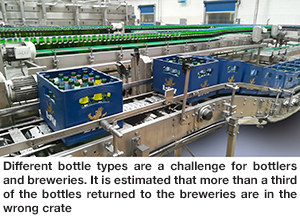Micro-Epsilon scanners enable height measurement and presence detection of beer bottles in moving crates
23/03/2020
 Non-contact laser scanners from Micro-Epsilon are being used to quickly and reliably recognise if all of the beer bottles are present and of the correct type in returned crates.
Non-contact laser scanners from Micro-Epsilon are being used to quickly and reliably recognise if all of the beer bottles are present and of the correct type in returned crates.Beer bottles that come directly from the filling line or the brewery to the customer normally take the same route back; as glass bottles are recyclable, they can typically be refilled 40 to 50 times. The bottles arrive in their thousands at the breweries to be checked, washed and refilled. To ensure a smooth procedure of further machine processing, such as the removal of caps and labels, as well as washing and refilling, it is necessary to inspect the crates at the goods inward stage. Completeness of the bottle is a crucial factor, but ensuring that the correct bottle type is in the right crate is also important.
Different bottle types are a challenge for bottlers and breweries. Often, the glass is trimmed with the brewery logo or the bottles have been specially shaped for a certain manufacturer. It is estimated that more than one third of the bottles delivered to breweries are in the wrong crate. Crates are often inspected manually, a process that is exhausting, subject to error and costly in terms of human inspection hours. The crates are moved on a conveyor belt, which demands a lot of concentration from the inspectors. If the inspectors become tired, the wrong bottles can slip through or some crates might be incomplete.
A more efficient inspection method, which is very reliable, involves the use of non-contact laser scanners from Micro-Epsilon. Slovak company Tipteh has developed an inspection system using laser-line triangulation sensors for fast, fully automatic inspection, which is already being used for the inspection of the received beer bottle crates. This in-line inspection system is equipped with five scanCONTROL 2900-50 laser scanners from Micro-Epsilon. In the production line, the scanners measure the crates from above as they are moved along a conveyor belt. Each scanner measures a row of bottles in the crates. Presence detection is carried out at conveyor speeds of up to 850 mm/s.
Compared with solutions based on conventional image processing systems, laser scanners not only monitor the presence of a bottle but also the height of the bottle. The sensor uses the bottle height to determine whether the correct type of bottle is in the crate. The bottle height must not deviate by more than 3 mm from the target height of the relevant bottle type.
The programmable logic controller receives the result of the evaluation as an ‘OK’ or ‘not OK’ value, whereby any faulty crates can be removed directly from the production line. The user can also output the measured results via an integrated display on the control unit.
With dimensions of 96 × 85 × 33 mm and an integrated controller, the scanCONTROL 2900-50 laser scanner is a space-saving automated solution for the inspection of empties at bottlers and breweries. The sensor operates at high speeds, up to 2000 profiles per second, and is therefore ideal for both static and dynamic processes. The challenges of this measurement task primarily lie in the different reflective properties of the bottles. These vary due to different glass colours (mainly green and brown tones). In addition, bottles can arrive with and without caps at goods inward and these are recognised by the scanner using prestored algorithms. The bottles are also constantly vibrating and shaking while being transported on the conveyor belt. As the sensor captures all points across the line simultaneously, Micro-Epsilon laser scanners overcome these challenges. They can be positioned at a large distance from the measurement object and detect 1280 measuring points per profile. They provide precise results, while being insensitive to vibrations. The measured values are evaluated directly in the production line. Via GigE Vision, raw data is integrated into image processing software and then evaluated. Data can be logged for subsequent statistical analysis, evaluation and process optimisation. The sensors therefore score highly in terms of their precision, speed and reliability, while offering an economic solution for this specific application.
The scanCONTROL laser scanner is based on the laser triangulation principle for 2D profile detection. It emits a laser beam, which is widened to a laser line that hits the measurement object. The laser light is reflected by the surface of the object and projected onto a highly sensitive receiving matrix in the sensor. In addition to distance information (z-axis), the controller also uses this camera image to calculate the position along the laser line (x-axis). These measured values are then output in a 2D coordinate system that is fixed with respect to the sensor. In the case of moving objects or a traversing sensor, it is therefore possible to obtain 3D measurement values.
www.micro-epsilon.co.uk